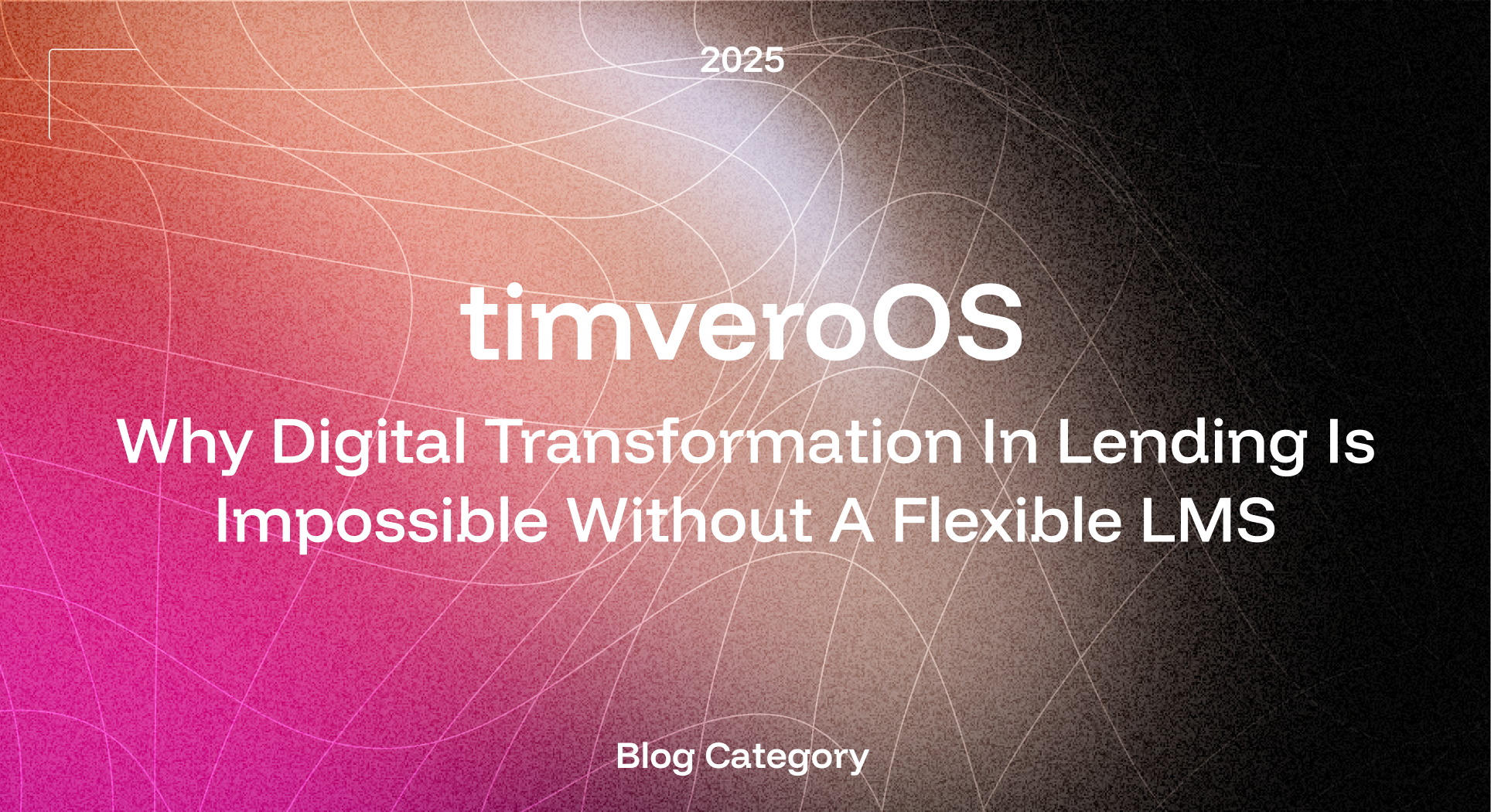Why Digital Transformation in Lending Is Impossible Without a Flexible LMS
Most institutions today understand the "why" behind digital change, but struggle with the "how." The gap between vision and execution often stems from a misaligned core platform, rather than a team's capability. A critical pillar of this fragmentation, usually overlooked, is the Loan Management System (LMS).
Legacy platforms may have served well in a static world, but today’s lending environment is anything but static. Most digital transformations in lending fail. Not because the ideas are bad. Not because the teams lack talent. But because the systems they’re built on were never designed to change.

Why a Flexible LMS Is Essential for Digital Lending Transformation
Every shift in borrower expectations, regulatory policy, credit risk models, or delivery channels creates new operational challenges that traditional systems struggle to absorb. Solutions must be flexible, not static. What works today could underperform tomorrow, and the only constant is the need for systems that evolve as quickly as the environment they serve.
Flexibility, in this context, is the defining characteristic of a modern LMS. The system can adapt without collapsing under the weight of change. A flexible LMS allows lenders to introduce new loan products without re-architecting their back end. It supports multiple servicing models, integrates with third-party data sources via APIs, and dynamically adjusts compliance rules as regulations evolve.
A rigid LMS traps lenders in a reactionary posture, where even minor changes require disproportionate effort. But a flexible LMS, by contrast, transforms this into a responsive architecture where lenders can operate along the problem–solution continuum with confidence, solving problems as they arise, and often before they manifest.
Building a Truly Unified, Scalable Platform
Digital transformation often fails when banks rely on siloed, outdated systems that lack effective communication. Staff waste time moving between platforms, re-entering data, reconciling discrepancies, and managing workarounds. Customers experience disjointed service, delayed approvals, and unclear communication. And based on a THL/McKinsey report, while nearly all banks have begun some digital journey, only 5% of executives believe they are close to completing technology upgrades, and most banks are less than 25% through transformation Legacy tech and disconnected platforms create inefficiency, internal friction, and poor experiences for customers and staff alike.
A flexible LMS rectifies this by integrating loan origination, servicing, analytics, risk, and compliance on a single platform. It becomes the digital spine for product configuration, data flow, and decision-making, eliminating siloes and enabling cohesive transformation. Legacy core systems are ill-equipped to handle the demands of modern lending, which now requires real-time updates, product flexibility, instant decision-making, and user-friendly digital interfaces. These systems are often inflexible, hard to update, and incompatible with new tools or cloud-native platforms. Quite inevitably, any digital "transformations" are surface-level: new front-end portals sitting on top of slow, disconnected back-end processes.
Well, a flexible LMS addresses this directly. It acts as a centralised operating layer that unifies loan origination, servicing, repayment management, compliance monitoring, risk analytics, and performance reporting. Instead of relying on external integrations to patch over system gaps, a modern LMS is built with a modular architecture that allows components to work together seamlessly and evolve independently.

Operational Efficiency from End to End
Modern lending involves numerous operational stages, including application intake, underwriting, credit decisioning, disbursement, repayment servicing, reporting, and compliance. When managed across disconnected systems, this process becomes cumbersome and prone to errors. Staff waste time manually transferring information, files go missing, steps get delayed, and borrowers suffer from inconsistent experiences.
A study by Allied Business Systems confirms that modern loan management software dramatically improves efficiency by centralising borrower data and automating every stage of the process. This digital consolidation enables faster decision-making and reduces errors.
Instead of juggling spreadsheets and physical files, a configurable LMS stores all borrower information, documents, and workflows in one secure platform. When processed consistently, onboarding becomes faster and more efficient, with fewer errors occurring, even in high-volume workflows.
Dynamic Product Innovation and Agility
Traditional lending systems, built around hard-coded templates and inflexible rule sets, are too slow to respond. Any changes to a loan’s structure, be it adjusting interest rates, altering term durations, or introducing a new repayment cadence, require technical intervention, often routed through overstretched IT teams. This lag kills momentum and creates a gap between what lenders want to offer and what they can actually deliver.
A flexible LMS closes that gap by allowing product teams (not developers!!) to configure and launch new offerings quickly and safely. With built-in logic editors, parameter-driven design, and modular settings, a team can create a microloan product with daily repayments, followed by a seasonal line of credit with deferred principal payments, all without writing a line of code. This responsiveness is crucial for lenders serving diverse segments, such as gig economy workers, agricultural producers, and informal businesses. These borrower types don’t fit neatly into conventional repayment frameworks, and their needs often require tailored product behaviour that adjusts dynamically over time.
But the value of this agility extends beyond customisation. It also supports rapid iteration. Lenders can A/B test interest strategies, introduce promotional periods, or launch time-limited products with minimal disruption to existing workflows. When paired with real-time analytics, they can monitor uptake, risk performance, and borrower feedback, adjusting product design on the fly. This innovation cycle allows lenders to stay ahead of market shifts, pivot during uncertainty, and address underserved needs far more effectively than legacy institutions locked into static offerings.

Better Risk Management Through Data
Truly effective risk management in lending depends on visibility: knowing where vulnerabilities are emerging, which borrowers are at risk of default, and what early signals suggest trouble ahead. Yet, in most legacy environments, risk data is fragmented across systems and arrives too late to be actionable. Manual reconciliation, delayed reports, and unstructured borrower data mean risk teams are constantly playing catch-up. This creates a reactive posture, where interventions come after delinquency rather than before.
A flexible LMS changes that dynamic. It centralises all loan activity in one place, anything from applications, approvals, repayments, communications, to behavioural trends. This continuous stream of structured data allows lenders to build real-time risk visibility into their operations. Early warning systems can be configured to flag payment irregularities, sudden income drops, or shifts in credit behaviour. Smart triggers can automatically escalate at-risk accounts, initiate outreach, or adjust terms without waiting for month-end reports or batch processing cycles.
Flexibility here means more than just having dashboards. It means being able to define your own risk thresholds, tailor responses by borrower segment, and integrate external data sources, such as alternative credit signals, mobile money flows, or industry-level economic alerts. Once loan data is structured, continuous, and centralised, it becomes possible to deploy predictive models that assess default probability, suggest credit limit adjustments, or even personalise repayment plans in real time.
Improved Borrower Experience and Inclusion
Modern borrowers expect digital experiences that feel personalised, seamless, and intuitive. They value transparency, responsive interfaces, and the ability to manage their loans without friction. Meeting these expectations requires more than surface-level digital tools; it actually demands a lending infrastructure that can adapt to the diverse needs and behaviours of the people it serves. A flexible LMS creates the foundation for this adaptability.
With a flexible LMS, lenders can offer application journeys that adjust in real-time based on the borrower's profile or product type. Features such as instant eligibility feedback, self-service portals, automated document handling, and repayment options tailored to financial patterns all contribute to a more efficient and confident borrower experience. These systems support variable term lengths, income-sensitive schedules, and multilingual access points, ensuring every borrower has a clear path through the process.
Flexibility also plays a critical role in financial inclusion. Many borrowers, particularly those operating in informal sectors or earning irregular incomes, require systems that can accommodate various verification methods, credit behaviours, and repayment capacities. A rigid platform would force these individuals to conform to a narrow definition of creditworthiness. A flexible LMS allows lenders to expand eligibility criteria, incorporate alternative data sources, and build financial products that reflect the reality of underserved populations.
Flexibility = the Critical Pillar for Digital Lending
As lending becomes more complex and customer expectations rise, only those platforms built for speed, change, and scale will be able to keep up, all of which depend on a truly flexible LMS.
Modern lending moves fast. Markets shift, products evolve, and customer expectations continue to rise. A rigid system turns every adjustment into a delay, and every delay into a missed opportunity.
.avif)
